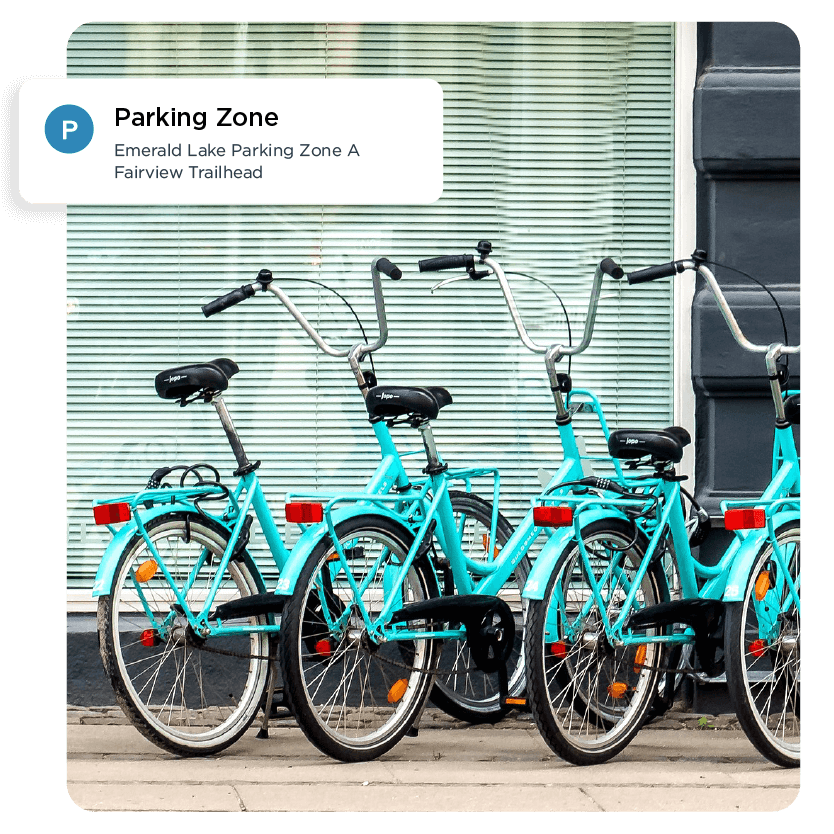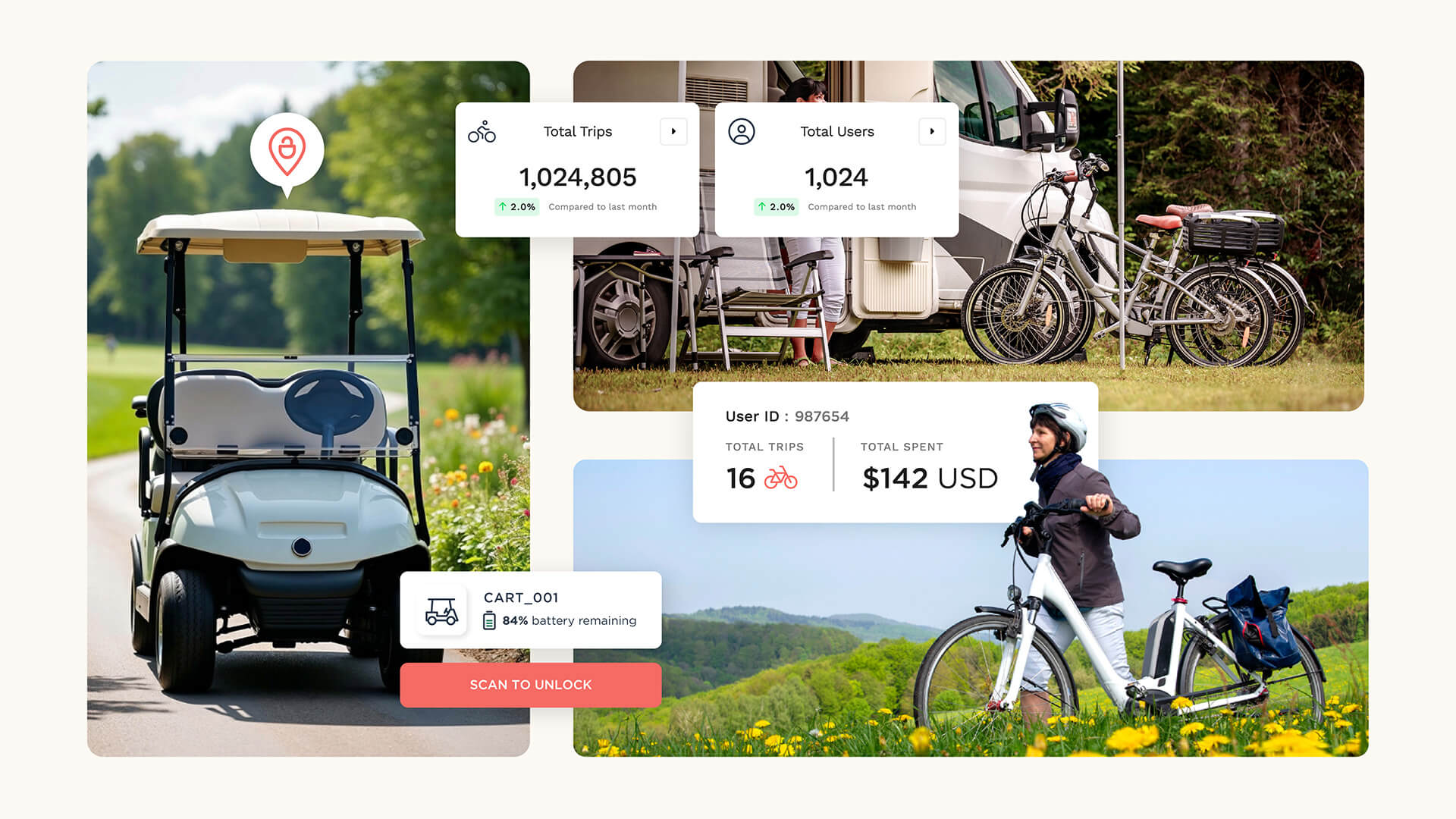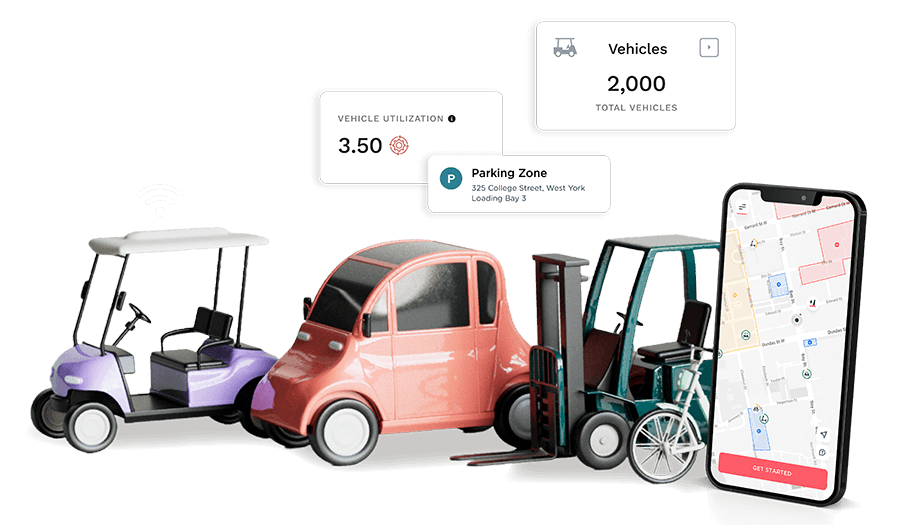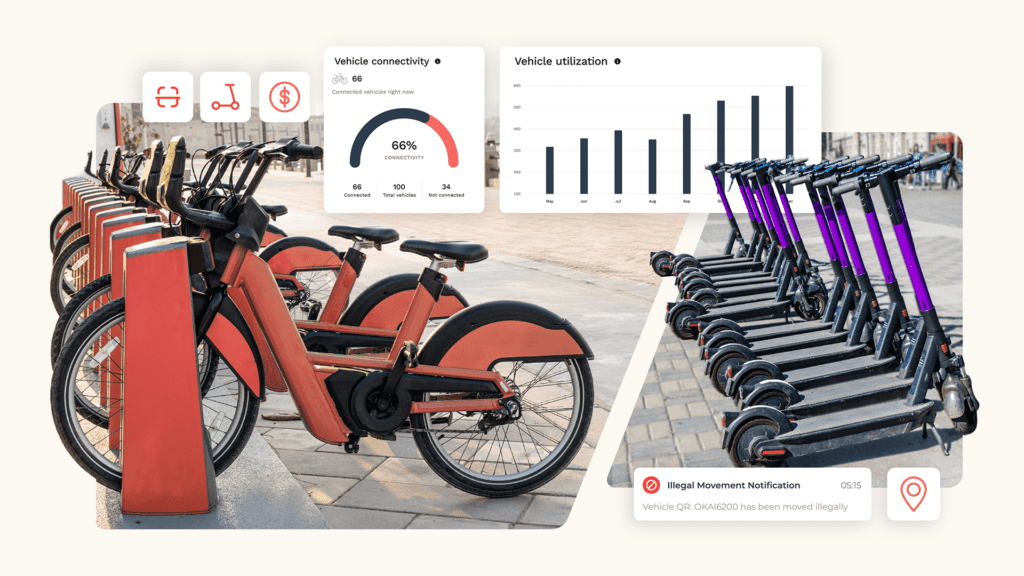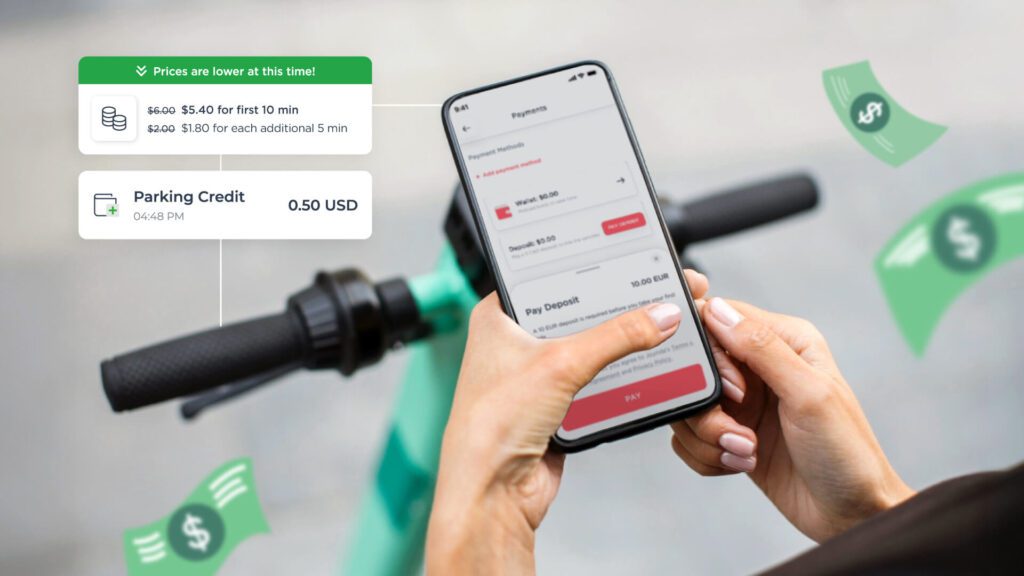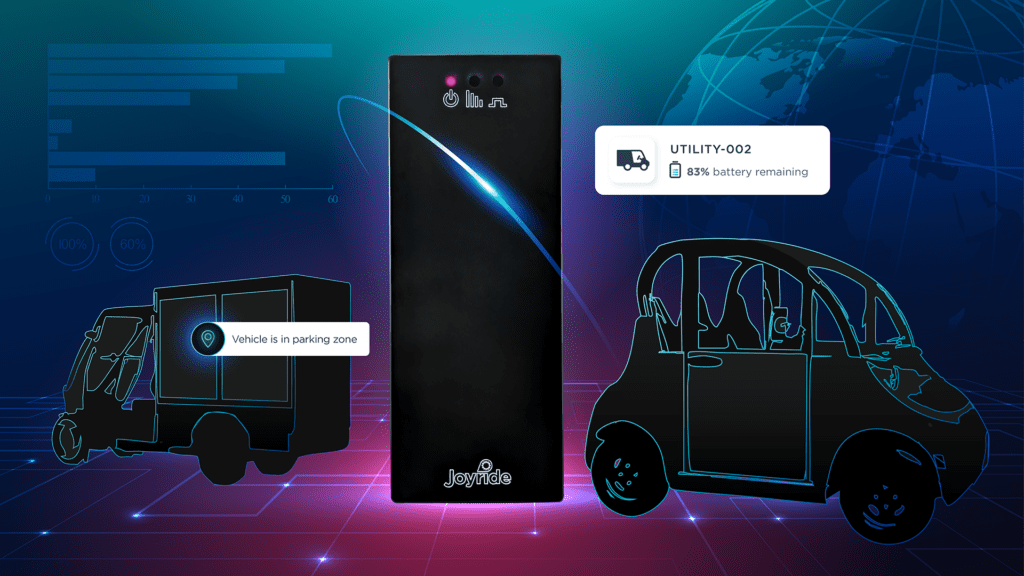Picture this: A family arrives at a campground, park or RV resort, eager to explore miles of trails or visit nearby attractions. Instead of waiting in line at a kiosk, they simply select an e-bike or golf cart nearby, scan the QR code with their phone, rent and unlock their ride—all in seconds. No paper waivers, no key handoffs and no delays at the point of rental.
Sound idyllic? By using a digital vehicle rental platform, the financial upside of offering e-bike and golf cart rentals at campgrounds is significant—and no complex setup is required. More than just an added amenity, it’s a high-margin, low-maintenance revenue stream that meets real visitor demand.
Let’s break it down:
How digital vehicle rentals became popular at campgrounds and parks
1. Post-pandemic influence
The pandemic was a catalyst for increased interest in outdoor recreation and accelerated the adoption of low-touch, high-tech solutions to meet social distancing rules—think QR code menus, mobile food-and-beverage ordering and self-service check-in kiosks. These innovations have stuck around because they offer undeniable benefits. Visitors appreciate the convenience, while businesses gain efficiency and reduce overhead. As a result, facility managers are doubling down on tech-driven experiences such as self-serve bike kiosks and keyless golf cart rentals.
2. Renewed interest in domestic travel
According to McKinsey, domestic travel already accounts for 75% of global travel spending. Amidst international tensions, rising inflation and tariff concerns, terms like ‘holistay’ and ‘staycation’ continue to trend as travellers seek budget-friendly ways to escape without crossing borders. For park operators—and even Airbnb hosts—this means greater demand for on-site amenities, including rental vehicles that allow visitors to explore more of the property without the hassle of bringing their own vehicle.
3. Luxury meets the great outdoors
Luxury camping–also known as ‘glamping’—is another fast-growing segment of outdoor hospitality. Rather than ‘rough it,’ some travellers want to experience the serenity of nature without sacrificing modern conveniences. From spa services to curated adventure tours, glamping accommodations offer premium amenities similarly found at hotels and resorts. Private e-bike and golf cart rentals fit seamlessly into this trend, enhancing the perception of exclusivity by providing guests with a hassle-free way to explore their surroundings in style.
Who’s willing to pay? The market for vehicle rentals at campgrounds
Visitors to RV parks, resorts, campgrounds and national parks aren’t a uniform group, but they share some key traits that make them ideal customers for a golf cart or bike rental service:
Families and Groups
Parents are always looking for hassle-free ways to get the family from A to B. Walking long distances with kids and equipment is impractical, making golf carts a huge value add at properties with spaced out activities.
Affluent Retirees
Many RV travelers are retirees who have disposable income and value convenience.
With time to fill, these visitors often stay for extended periods (weeks or months), creating recurring rental opportunities.
Luxury Travelers
Guests visiting upscale properties expect premium services. They view vehicle access as part of the experience, similar to paying for a private boat dock. Their mindset? “I’m on vacation—let’s make it easy and fun.”
Fleet size: How many vehicles should be available?
The ideal number of rental vehicles at a campground, park, or RV resort depends on visitor volume, average stay duration and guest turnover. As a general rule of thumb, this ratio ensures that there are enough vehicles available to meet demand while minimizing idle inventory:
Golf Carts: 10-20 per 100 campsites
Bikes / E-Bikes: 15-30 per 100 campsites
Bikes and e-bikes provide easy a fun and leisurely way to explore surrounding natural beauty, while golf carts are convenient for groups, families and day trips to the beach or nearby towns. Where possible, a mixed fleet is ideal to meet the needs of every guest.
Profit potential: How should vehicle rentals at campgrounds be priced?
At campgrounds and parks, golf carts typically rent for $75–$150 per day for 4- or 6-seater models, with premium RV resorts charging $200 per day or more.
Rental rates for bikes and e-bikes range between $20-$65/day or $5-10/hour. E-bikes tend to command a higher hourly rate than pedal bikes and are a great upsell for active travelers who might not normally consider a rental, but view riding an e-bike as a novel vacation experience.
When it comes to profit potential, it’s all about utilization, meaning how often vehicles are used versus sitting idle. A golf cart sitting unused is an expense. A golf cart renting for $100 per day and used 90 days a year? That’s a $9,000 revenue stream per cart. Scale that up with a small fleet, and suddenly, rentals become one of the most profitable services at your campground.
Accounting for seasonality, and typical fluctuations in demand, here’s what the annual revenue potential for a mid-sized campground could look like:
- Fleet Size: 15 carts, 30 e-bikes
- Daily Rate: $150/day (carts) $40/day (ebikes)
- Utilization Rate: 80% (12/15 carts and 24/30 e-bikes rented daily)
- Season Length: 120 days (4 months)
- Peak Days: ~90 days (3 months)
- 12 carts × $150 × 90 days = $162,000
- 24 e-bikes × $40 × 90 days = $86,400
- Total Revenue: $248,400 per year
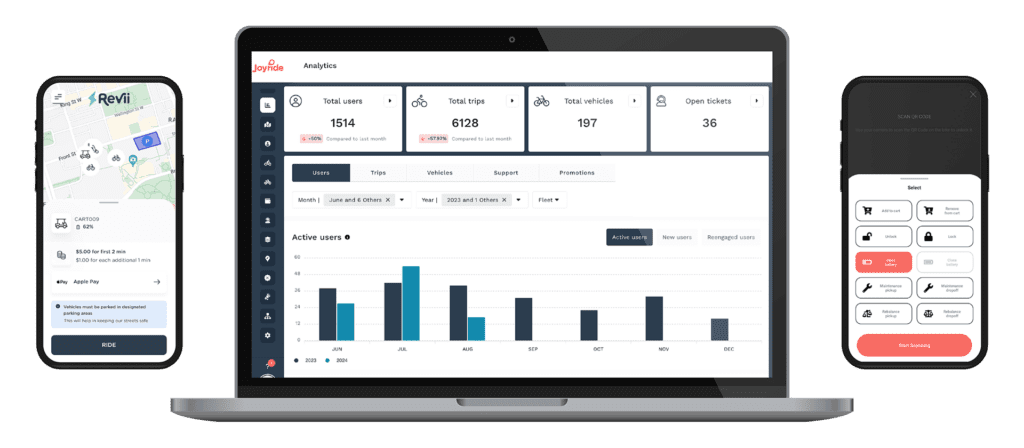
How does it work? Setting up digital vehicle rentals at campgrounds and parks
The financial upside of a rental fleet sounds great, but then there’s logistics and maintenance. What if an e-bike runs out of battery mid-trail? Or a golf cart goes missing? That’s where smart vehicle software makes all the difference.
With Joyride’s fleet management dashboard, facilities managers gain a better understanding of vehicle utilization, maintenance needs and guest preferences to improve service.
- Battery Tracking: Provides visibility into which vehicles are fully charged
- GPS Tracking: Shows where vehicles are in real-time and logs every trip
- Usage Heatmaps: Helps optimize fleet distribution based on customer travel patterns
- Geofencing: Keeps vehicles within pre-determined zones, reducing risk to pedestrians and protecting delicate ecosystems
- Work Orders and Support Tickets: Identifies small issues and assigns them to facilities managers before they become costly repairs
- Dynamic Pricing: Readjusts rental rates for busy weekends and to incentivize use during off-peak hours
On the customer side, Joyride’s Rider App is what facilitates every adventure. Campground guests use it to reserve and pay for vehicle rentals—but that’s not all. With geofencing, banners and push notifications, the app can also guide guests to scenic views and hidden spots. It’s a digital key and tour guide all in one:
- Custom Map Zones: Highlight paid activity zones, photo-ops and hidden gems on the property
- Group Rentals: Enable families and groups to rent multiple vehicles in a single transaction
- Safe Ride Plugin: Test driver reaction times at night to prevent driving under the influence
- Exclusive In-App Offers: Prompt purchases at on-site amenities and concessions with in-app promo codes
- Referral Program: Rewards guests for referring new users
What if vehicle rentals ran themselves?
It’s a balancing act: Helping visitors to unplug while creating memorable, accessible experiences with tech.
Digital vehicle rental software lets you do both by making it a seamless experience for everyone involved. With on-demand access to golf carts and bikes, guests can explore the beauty of nature at their own pace, while you gain new paths to recurring revenue.
Ready to learn more? Let’s talk about how Joyride can power this profitable, high-margin amenity at your campground.
